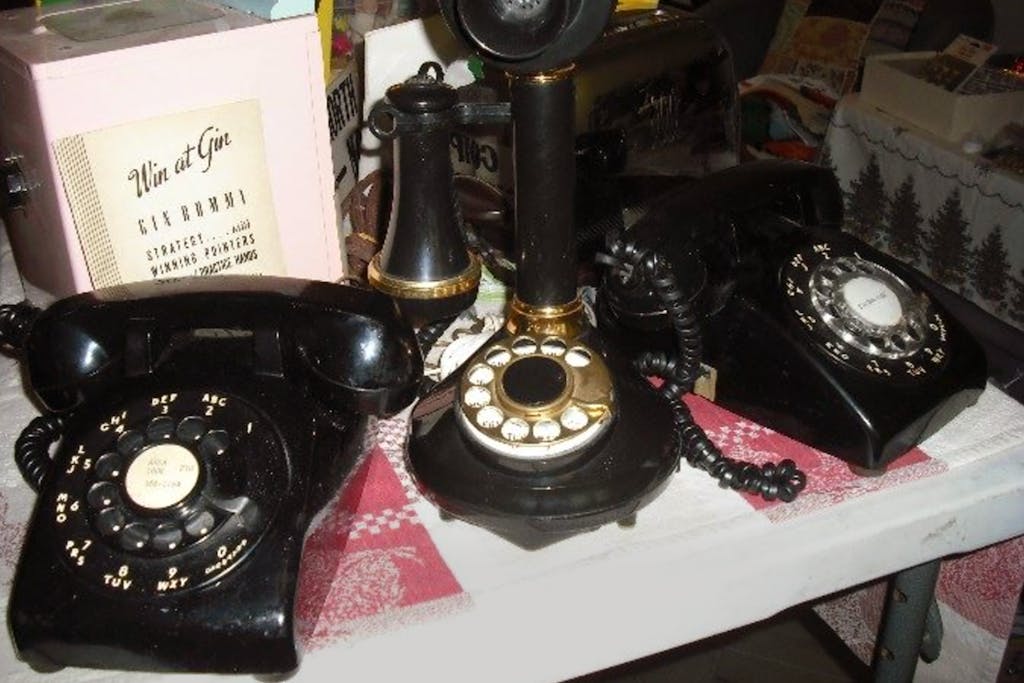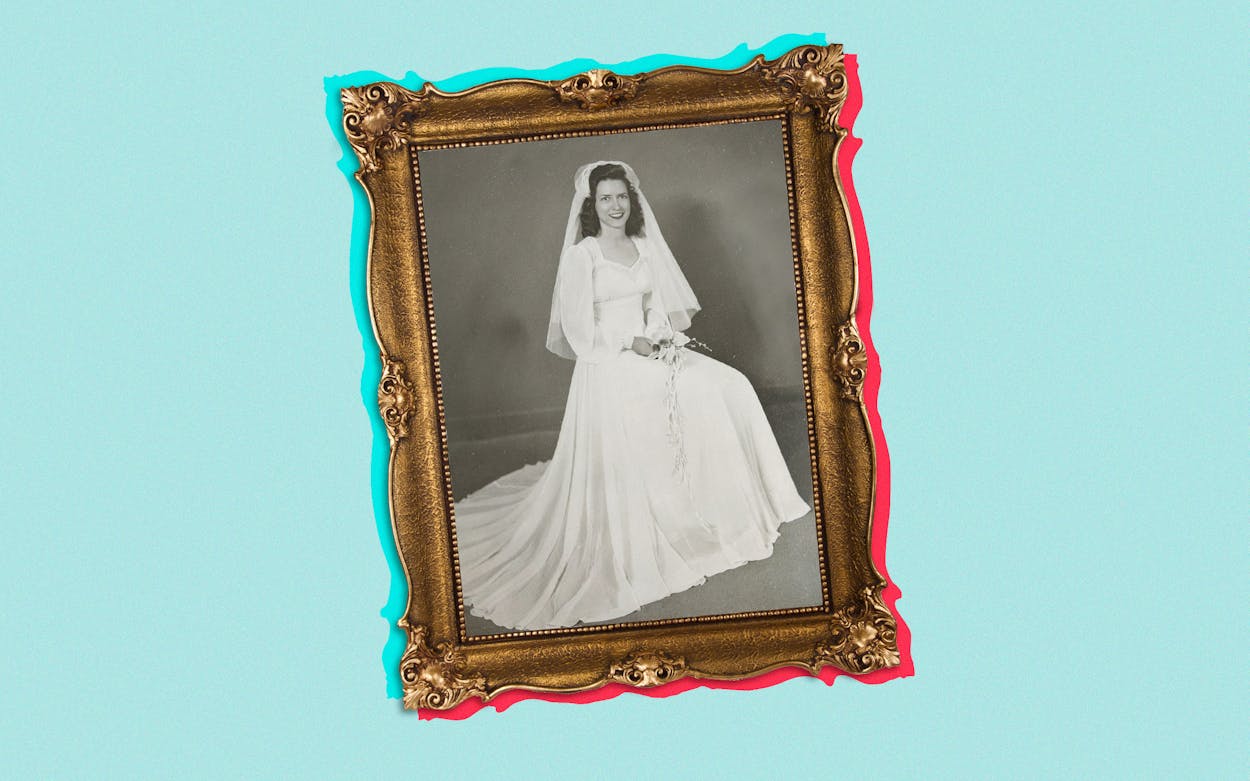The garage has always been my husband’s domain. It’s his space in our South Austin home, and he’s decked it out with a TV for watching games, a stereo for loud, late nights, and an Eagle Rare bourbon bar mirror. But after I moved my 71-year-old mom into an assisted living facility last year, I had to empty out her house in Kyle—which was filled with both her belongings and those of my grandmother June, who died in 2016. Boxes of photos, slides, letters, and other ephemera soon filled my husband’s space. I began referring to this collection as the Family Museum. The museum smelled like my grandmother June: a blend of True 100s cigarettes, Chanel No. 5 eau de toilette spray (which she called “toilet water”), and Dorothy Gray Satura moisture cream.
As I sorted through my mother’s belongings, plopped between my son’s bicycle and the flatscreen, an estate sale liquidator was over at my mom’s house, pricing the things I could sell. These were the objects I wouldn’t keep—items that, while they feel like home, can be found at almost any Texas estate sale: seventies Corningware with blue flowers, pottery purchased in border towns on tipsy day trips, Christmas ornaments, rotary telephones, seashells collected during walks along the Gulf Coast, books, Root candles, raincoats, mason jars, a rake, a shovel, and boxes with tiny plastic drawers full of loose nails and screws. Back when I moved into my first apartment, June taught me to scour estate sales for furniture, decor, and kitchen implements. She taught me to scan the inventory on the first day of the sale and buy whatever I couldn’t live without, but also to hold out on a few items and return on the last day of the sale for discounted prices. She taught me that part of the pleasure of estate-sale shopping is sneaking a peek at the house, especially when we went to the estate sales of noted artists and architects in San Antonio, where June lived. What she didn’t teach me during these late-nineties-to-early-2000s shopping dates was what it’s like on the other side of an estate sale, when you’re not the shopper. When you’re the one emptying out your family’s home, it can be bittersweet.
Each time I went to my mom’s house during the professional pre-sale sorting, staging, and pricing process, her once-cozy home—“Grandma’s house,” to my son—looked more like a retail space. McKenna Kuhr, the liquidator, set up tables of Christmas decorations against a living room wall. The kitchen counter looked like a busy Williams Sonoma display; the garage like the Lowe’s Garden Center. Just seeing life’s detritus categorized and organized, fluffed up and dusted off was simultaneously satisfying and shocking, and eventually every piece of my family’s life had a price tag. I processed the grief through journaling, late-night beer-fueled talks with my husband, and texts with friends. “I feel weird selling my grandmother’s wedding dress from the forties even though I have no use for it,” I typed in one of my group chats. “We had a tag sale for my grandparents’ belongings,” a dear friend replied. “It is weird, people walking through, tossing out offers, and carrying out things on their backs.”
Then the first day of my mom’s estate sale arrived, along with a text message from Kuhr: “SLAMMED! 25 people in line, 10 inside.” She called me later that night to debrief: Mom’s neighbor had purchased the heavy, stainless-steel vintage toaster that my husband nicknamed “the Buick.” Two women waited in line for an hour to buy the plastic drawers of screws and nails in the garage. One man purchased all three rotary phones. A woman bought $300 worth of Christmas decorations and said she would return on Sunday to buy more at discount.

June loved shopping estate sales and had hoped hers would be a good one; in this iteration—her belongings going like hotcakes at her daughter’s estate sale—it was. Items that had been stagnant were delighting each buyer. I imagined people photographing their treasures, making room for these new finds, sending braggadocious, jealousy-inducing texts to friends, and feeling glad they went to this estate sale.
At the same time, the knowledge that shoppers were leaving with pieces of my family’s history made me feel hollow. I teared up at the thought of selling my grandmother’s Duncan Phyfe dining table, along with its chairs and leaf extension, where I’d devoured Christmas dinners while sitting next to second cousins. Then I got some strangely satisfying news from Kuhr: my grandmother’s beaded-bodice 1945 wedding dress was sold to Reagan Wells. Wells, who goes by @reaganretro on social media, planned to turn my family’s history into an actual history lesson for her 37,000-plus followers on TikTok.
This was an app unknown to me. Sure, I’d watched the viral video of the guy drinking cranberry juice while skateboarding to Fleetwood Mac, and I had seen friends sharing that ubiquitous baked feta pasta recipe. But I was otherwise oblivious. Kuhr told me that Wells was one of her favorite young customers who “always knows when I have beautiful vintage pieces.” She’d purchased not only my grandmother’s wedding dress but also the very poufy lace dress my mother wore as a bride in 1972. I went to the garage, dug through the family museum, and found bridal photos of both women. I sent snapshots of the portraits to Kuhr to share with Wells.
I learned that Wells is taking classes at Austin Community College and has applied to a four-year university, where she wants to major in art history. She collects vintage artifacts to preserve them and learn their stories, which she then shares on her fashion history–focused account. My grandmother June isn’t even the only 1940s University of Texas coed whose vintage clothing Wells has acquired. It brought me joy to think of a college freshman—coincidentally at the school where I teach English—connecting to history via objects worn by women who attended Texas universities during World War II.
Weeks after Wells bought both dresses and posted them on TikTok, I finally caught up with Kuhr and got Wells’s TikTok handle. I brought my laptop to the couch, sat next to my husband, and gave in to the pull of yet another social media app, creating my own TikTok account not to post videos but to follow accounts, including hers. Immediately, I saw my mother and grandmother in her grid of videos, the faces in their bridal photos covered with flowers for an aura of privacy. I clicked on my mother’s flowery face first. “Everything truly is bigger in Texas,” Wells captioned this video, alluding to the sheer quantity of lacy fabric used to make my mother’s dress. As the opening bars of The Supremes’ “Where Did Our Love Go” filled my tiny laptop speakers, I watched Mom’s bridal portrait in the first frame, before it cut to Wells wearing the dress in her own home. She pointed out the details of the garment—the original mesh floral veil, the volume of the skirt, and the stains.
I had never known my mother as anyone other than Mom. As far as I know, she’d never tried on her wedding dress after the big day, and I certainly never saw her remove it from her closet. Now, watching Wells give us the front view of the dress, do a half-spin to show the back view, then walk away from the camera a bit, Say Yes to the Dress–style, I saw my mother’s dress move for the first time. I imagined how she must’ve felt trying it on in 1972, when she was a young bride beginning a new life. During a visit to her assisted living home a few days later, I showed Mom her bridal portrait. “La Feria,” she said, lucidity breaking through the dementia cloud. Moments earlier I’d reminded her what day it was. “I’m sorry?” I asked. “La Feria,” she replied with a smile. “That’s where I got the dress. It was a shop in San Antonio. Downtown.”
Back on the couch, laptop open and having just watched Reagan spin and take a few catwalk steps in Mom’s wedding dress, I needed an emotional intermission. I watched another of Reagan’s videos, an “Is it vintage or not?” explainer in which she showed a clutch bag and took the audience through her vintage hunting process. “She’s a clothing nerd, and she got my mom’s and my grandmother’s dresses,” I said out loud to my husband. “These dresses found the best home.”
My husband and I watched Reagan’s video of my grandmother’s dress next. This time the soundtrack was Glenn Miller’s “Moonlight Serenade,” a song I knew June loved. There were no stains on this dress, no poufy volume to joke about, no zipper—only a side hook-and-eye closure and beading detail on both the bodice and the veil. The video had racked up lots of comments, from “OMG i am crying this is stunning” to speculation as to what a 1945 bride would have worn under her clothes.
There it was: June’s wedding dress, out there for public consumption on the internet. June was a chemistry teacher, an educator herself, and now Wells was on my laptop screen educating her followers about vintage clothing. Letting go of life as I knew it even a year ago—knickknacks no longer arranged neatly on shelves at my mother’s house—has been difficult. But these TikToks and the ongoing project of sorting and archiving the family museum are the salve.
- More About:
- Style & Design
- Fashion






